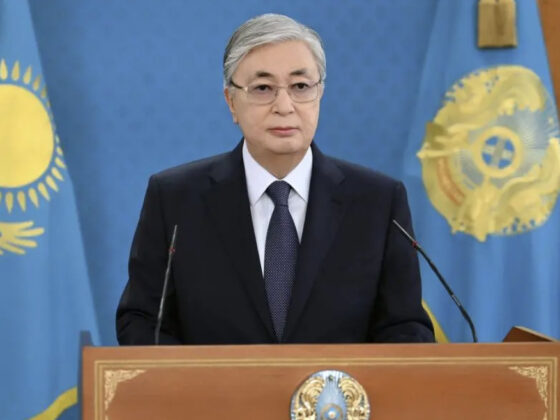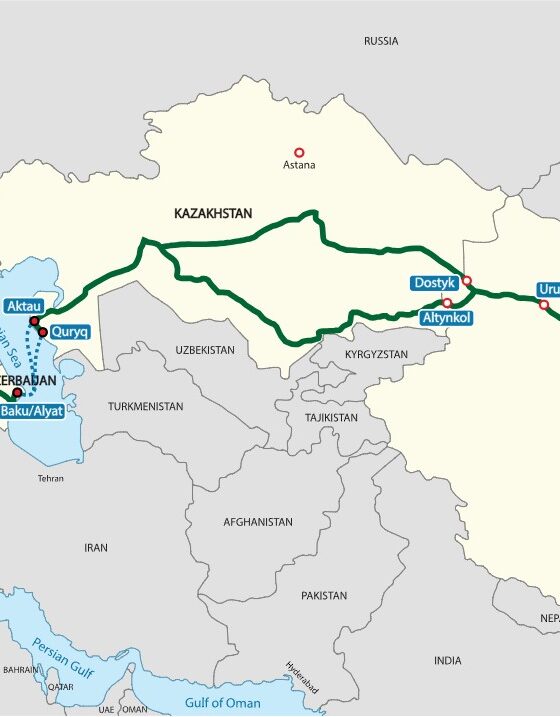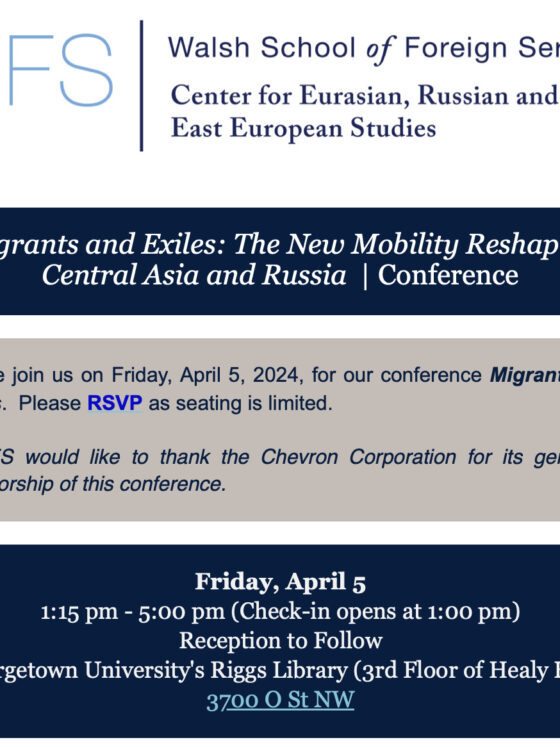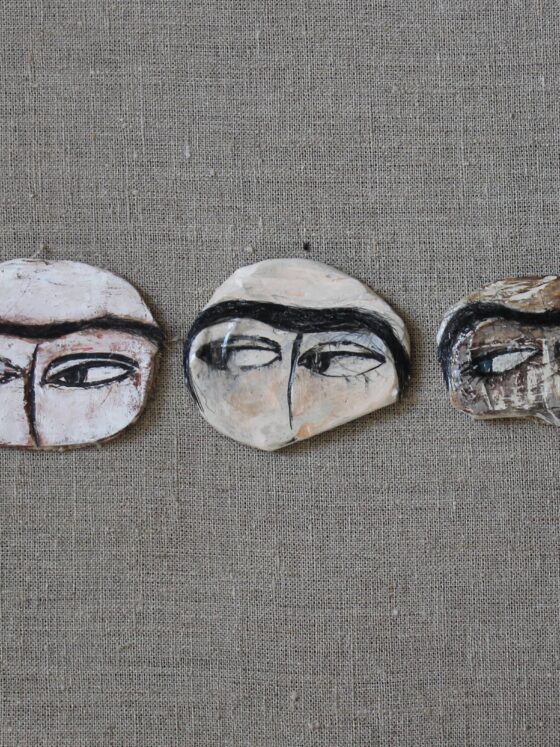
Formalities of Contemporary Central Asian Militaries
March 2024
Author:

László Kövecses is currently a PhD student in History at Pázmány Péter Catholic University, Budapest. Previously he earned his MSc degree at the University of Glasgow in Russian, Central and East European Studies in 2015 and his BA degree in History with Geography minor at Eötvös Loránd University (Budapest) in 2013. His main research interest is Hungarian national identity in the early modern period (1500-1800). He is a member of the London-based Association for the Study of Ethnicity and Nationalism. Kövecses published articles in English so far in the journals Nations & Nationalism, Ephemeris Hungarologica, Hungarian Review and other websites.
Contributing Editor:

Christopher A. Ellison is the Editor at the Institute for European, Russian, and Eurasian Studies at The George Washington University. He received his BA, cum laude, in Political Science and Literature from the University of California at San Diego; his MALD from the Fletcher School of Law & Diplomacy at Tufts University; and his MA in Economic History from Rice University, where he also studied at the James A. Baker III Institute for Public Policy. He is a board member of the anticorruption nonprofit organization Fides Intl., and a former Fulbright Fellow.
Abstract
The Soviet Russian heritage of the armed forces of the states of Central Asia seemingly lives on unbroken in most of the region, despite the nationalist slogans proclaimed by politicians. This essay aims to resolve this contradiction by giving a brief overview of the modifications in Soviet- and Russian-style military uniforms in use in Kazakhstan, Kyrgyzstan, Tajikistan, Turkmenistan, and Uzbekistan, while applying a semantic approach. Besides a literature review of monographs and articles, professional blog posts from the internet have also been surveyed as part of this analysis. This essay identifies three major reasons for the lack of a coherent symbolic transformation of uniforms: (1) the over-representation of ethnic Russians in the officer corps in the 1990s, (2) the inverse proportionality of ethnocentricity and uniforms bearing national elements, and (3) the lack of established traditions of a unified national army dress predating the period of Russian dominance beginning in the 1860s.
Introduction
The young republics of Central Asia seek to find a strong historical basis for their own existence ever since gaining independence from the Soviet Union in 1991. Many scholars have written numerous books and articles on the topics of identity formation (Bassin and Kelly 2012), aggressive nationalism (Everett-Heath 2003), and collective memory (Paskelava and van den Berg 2023) in this region. Mostly the negative effects of this process are highlighted, portraying these counties as very anti-Russian and intolerant towards their ethnic minorities. Although this narrative does have valid points, I wish to shed light on another aspect of nation-building: the Soviet Russian heritage of the armies in these post-Soviet states, a legacy which seems to live on unbroken in the majority of Central Asia despite the nationalist slogans proclaimed by politicians. What may the reasons be for this strange contradiction? Is it not awkward that just the military, which should be the most straightforward expression of state sovereignty, lacks a self-image of its own?
In this essay I aim to resolve this contradiction by giving a brief overview on the changes in Soviet- and Russian-style military uniforms in Kazakhstan, Kyrgyzstan, Tajikistan, Turkmenistan, and Uzbekistan, and also take a glimpse at the Caucasian republics of Armenia, Azerbaijan, and Georgia. Uniforms, insignia, parades, and other mass spectacles function as signifiers of the state that can be understood easily by ordinary citizens and other states all around the world through the process of denotation. Therefore, I wish to embed this topic into a semantic approach. Semantics, as the study of meaning, may be very useful in decoding the messages these signifiers stand for. Semantics, as a branch of semiotics, is widely used in linguistics, psychology, and computer science, but less often associated with the auxiliary sciences of history, the context in which I intend to make use of it here.
Among my sources I did not only use printed materials such as books and articles, but also relied on blog posts from the internet. In many ways my approach was inspired by Christopher Schwartz, who has applied phenomenological treatment to his data set, which includes interviews, emails, and blog posts, while analyzing the relics of 1991 from an intergenerational point of view (Schwartz 2014). By relics, Schwartz means consumer products, borders, currencies, and alphabets, which function as signifiers of a generation, and necessarily went through essential change after the fall of the Soviet Union. Interestingly, he comes to the conclusion that younger generations are much less open-minded in Turkmenistan (the exact opposite of the usual trend globally, nowadays) as a result of their limited opportunities to study in Moscow or to vacation in Crimea, and thereby become familiar with the broader former Soviet Union (p. 198). Provincial mentality is also tangible when studying the structure, the mechanisms, and the formalities of most of these post-Soviet republics.
As outlined above, political changes in Central Asia after 1991 led to brushing up national culture and traditions in public life: why would military uniforms be exempt from these? In this essay, I would like to discuss the oft-cited concept of “political primordialism” (Kudaibergenova 2014, p. 160) and to trace the possible ways of nationalizing the image of the army.
New ideology, new formality?
National ideology formation became outstandingly important for the new states of Central Asia after gaining independence from the former Soviet Union. They faced a difficult task: in the past couple of centuries they had been part of either the Communist Soviet Union or the Tsarist Russian Empire. The major goal was to find any era that had been free of subjection to any other empire and, as such, faithfully reflected the ancient glory of that particular nation. Continuing this train of thought, the tsarist era is mostly criticized by Kazakh and Kyrgyz historians for the devastating human losses it caused to Central Asian peoples during World War I. Nevertheless, the formation of the Soviet Red Army is seen as a positive development by present-day military elites (Marat 2010, p. 119). On the other hand, presidents of these newly born states have often referred to the Soviet era in their speeches as a case of “colonialism” (Uzbekistan), a “gloomy era with unwanted legacies which should be eradicated” (Turkmenistan), or an era full of “devastating demographic stabs” and the Soviet empire as the “prison of peoples” (Kazakhstan) (p. 121). Renowned English historian Norman Davies (2012, p. 721) underpins these claims by arguing that these different nationalities assembled by the USSR were held together by coercion: “As soon as the coercion was removed” by Gorbachev’s policy of glasnost (openness) and perestroika (reconstruction), “almost all the non-Russian republics prepared to leave, exactly as they had in 1918.”
FIGURE 1. Equestrian statue of Manas in Bishkek, Kyrgyzstan

SOURCE: Wikipedia Image
In the light of this anti-Soviet morale, the creation of national symbols and the re-discovery of the ancient past by way of the veneration of historical heroes (baatyrs)—that is, political primordialism in practice—became of paramount importance (Kudaibergenova 2014, p. 164). A new narrative of the past was often intertwined with historical military themes, such as the cult of Seljuk Beg in Turkmenistan1, Manas in Kyrgyzstan2, Amir Timur in Uzbekistan3, or Abylai Khan4 and Altyn Adam (Golden Man)5 in Kazakhstan. These historical and sometimes semi-mythological heroes represent the ideals and dominance of the titular nationalities living in each state. Having said that, we have also touched on a new issue: in these young Central Asian states, usually there are a number of ethnic minorities living within the present-day borders. They are often ignored in official propaganda and regarded generally as second-class citizens (see Everett-Heath 2003). To be most precise, therefore, we should use the term ethnocentric nationalism when referring to the nation-building aspirations of these countries. This distinction makes a difference in the military sense as well, since it largely determines the type of armies these countries operate. Modern, Western armies mostly prepare themselves for international peacekeeping activities, such as the missions of NATO and UN troops all over the globe. Central Asian states, however, primarily train to defend the titular ethnic group in the country from external and internal enemies, thereby diminishing trust among neighboring states and ethnicities (Marat 2010, p. 119).
The ironic twist in creating a Soviet-free world is that the actual methods used to achieve this are pretty similar to those applied by that same undesirable old regime. For example, public spectacles, which often serve a similar purpose to that of military parades, function according to the same dynamics as their older counterparts. The active participation of citizens in these events is emphasized by political and cultural leaders, as opposed to the public being mere spectators at a Communist parade. However, researchers point out that this kind of involvement is only an illusionary participation on the part of the masses, as these occasions are choreographed in advance do not require any real input on the part of the citizenry (Adams 2010, p. 96). The so-called performative shift means simply that people, public celebrations, and documents represent a similar set of ideas defined by the centralized state, which monopolizes the public sphere. In this manner, only the nature of the performance changes; the basic method of conveying the message remains intact (Marat 2010, p. 116).
The reason for the lack of radical change is that even more than 30 years after gaining independence, the leadership of these states consists mostly of Soviet-educated personnel. These elites of course utilize the available templates they are familiar with, which happen to be Soviet ones. We can see the same logic in action when the national heritage is being revived selectively in order to avoid elements that could cause tension within the contemporary interpretation of the historical past, “as the Soviets also selectively prescribed the form and allowed heroes” (Kudaibergenova 2014, p. 170). At this point I would like to note that an inclination for selective memory is characteristic of every society.
Military implications of nationalist ideology
Having reviewed how political changes affected societal attitudes towards national culture following independence in 1991, let us now turn our attention specifically to military uniforms. First of all, we need to know what kind of dress patterns are available in folk culture to be transformed into male military uniforms. Men’s costume consists mostly of the same garments throughout the region (Abazov 2007, p. 172).
FIGURE 2. The Emir of Bukhara (Western Uzbekistan) wearing a chapan in 1911.

Source: WikiPedia Image
The basic wear is a long-sleeved shirt without buttons and baggy trousers. Over these, a cotton-quilted robe, called chapan or don depending on the nationality of its wearer, is worn. On their feet they wear either tall leather boots or moccasin-style shoes. Finally, on the head a fur cap or a felt hat is worn, which is the most distinguishing garment among all. The Turkmen mostly wear a sheepskin hat made out of the fur of the famous Astrakhan lamb, Tajiks and Uzbeks wear a skullcap called a depe, and Kazakhs and Kyrgyz wear a pointy hat called a kolpak.
FIGURE 3. Turkmen wearing Astrakhan fur hats.

Source: reddit image
In Russian, an Astrakhan hat is called papakha, which became a typical garment of Russian and Soviet winter military uniforms during the campaigns in the Caucasus Mountains in 1855. This fur cap, resembling its Turkmen counterpart, could be seen as the adoption of a formerly strictly ethno-national attribute in the Soviet Army (Barker 1976, fig. 9, 33, 43). Baggy trousers can also be seen as a sort of national element in the army, since the breeches are obviously a modern-age version of this ancient form of jodhpurs (Barker 1976, p. 12). After all, it looks like the Red Army was not as antagonistic towards minority Soviet-nationalities as one might think at first.
In current Central Asian armies, we can still find long boots on the parade troops as one of the last bastions of traditional folk culture. Another national distinctness in the case of Kazakh uniforms are the shoulder boards embroidered with stylized folk motifs (CSM 2011b). Shoulder boards and collars are crucial parts of the uniform in general, as these are the places where the chevron (in other words, the badge of rank) is placed. Although nowadays homemade garments of traditional dress are seldom worn in Central Asia due to factory mass production, many men in these countries still wear at least one garment representing their rich traditions, mostly a hat (depe or kolpak) or an Oriental-style belt (Abazov 2007, p. 174). This respectable custom, however, is not typical of the armies of the other Central Asian republics, which basically adapted nothing of their traditional folk costumes, unlike the Kazakhs.
New foreign relations, new formalities?
After seceding from the crumbling Soviet Union, Central Asia’s new states had to define their own independent foreign-policy orientations towards the rest of the world. Naturally, they did not have too much elbow room, as both politically and economically (not to mention militarily) they were still closely attached to Russia. To put it more diplomatically, Russia went from being their domestic center of gravity to becoming their primary foreign partner. These close links were mostly secured by the Commonwealth of Independent States (CIS), an organization controlled from Moscow. Initially, Russia even wanted to maintain a common border guard corps, but after giving the command into national hands in 1993, the successor states took control of military units stationed on their land. The strong ties to the Russian Federation have only begun to loosen in the 2020s, and the ongoing Russo-Ukrainian War will most probably accelerate the former Soviet republics’ drifting away.
Close cooperation was necessary for other reasons as well. The civil nuclear energy of the former Soviet Union became dispersed among four countries: Russia, Ukraine, Belarus, and Kazakhstan. This new strategic situation raised Kazakhstan among the great powers in a certain sense. The fact that the Baikonur Spaceport, operated in cooperation with Russia, also lies on Kazakh soil has strengthened the country even further. This idyllic situation from the Kazakh point of view did not last long however, as both the United States and Russia had a share in weakening Kazakhstan’s military capacities. By the spring of 1995, Kazakhstan’s nuclear weapons had been either dismantled or shipped back to Russia; Kazakhstan received US $85 million in compensation from the United States in return (Olcott 1996, p. 71). The debate on the right over shared usage of the Baikonur Spaceport was solved a year before, in March 1994.
Other states also had to face the intentions of distant global powers to interfere. Uzbekistan was approached by United States Defence Secretary William Perry, who offered support in setting up a new national army in 1995 (Kulchik 1996, p. 42, 47). This offer was probably not made at the best time, since Uzbekistan had already signed a bilateral security treaty with Russia, which specified that the contracting parties could use each other’s airfields and anti-aircraft weapons systems on a mutual basis, that they should cooperate on issues of military training and armaments, and that they would not take part in actions construed as hostile by the other (Olcott 1996, p. 131). Later on, however, Uzbekistan adopted a policy of strict neutrality concerning military affairs, and consequently left the Collective Security Treaty Organization (CSTO).
The degree of commitment to Russia was high among other Central Asian countries as well. Tajikistan, for example, earned 70% of its annual national income in 1993 from Russia (Olcott 1996, p. 120). When experiencing such incredible financial dependence on another state, it is obviously false to talk about a fully sovereign and functioning state apparatus. Even so, Tajikistan celebrates its independence from the Soviet Union each year with a grandiose military parade as do Kazakhstan and Kyrgyzstan. In 2006, Turkmenistan also organized a parade with tanks, artillery, fighter aircraft, and cavalry. This exceptional event cannot be separated from the megalomania of Saparmurat Niyazov, the late self-styled “Leader of the Turkmen” (Türkmenbashy). While in Soviet times parades took place on such illustrious Communist holidays as Labor Day (May 1), Victory Day (May 9), or the Anniversary of the Great October Socialist Revolution (November 7), in the new era, Central Asia’s mass spectacles are organized on these nations’ independence days.
Military implications of foreign orientation
The largely constrained foreign orientation of the Central Asian republics towards Russia is a result of both the Soviet heritage and of need. Both of these aspects are twice as true of these nations’ armies. The Soviet heritage is primarily conspicuous when examining the ethnic composition of the officer corps: the bulk of the officers in all Central Asian republics in the 1990s were Slavic (Kulchik 1996, p. 39; Olcott 1996, p. 74), although nowadays their proportion is declining as new, indigenous generations of officers are trained. The loyalty of these non-titular-nationality officers posed a great problem to the state authorities for a while after secession from the Soviet Union, as sometimes even presidents had difficulties in accessing military secrets because of the Russophile general staff (Olcott 1996, p. 46). The case of former KGB agents was an even more delicate issue of dual loyalty. The Central Asian republics’ Russian orientation was not only strong within their armies because of their ethnic-Russian officer corps, but also because their military training often took place in Russia, as the case of Uzbekistan demonstrates.
However, the decreasing number of ethnic-Russian personnel in the armies of the Central Asian republics has a major downside, too. Certain functions, such as border patrolling, would have been non-operational without the assistance of the Russian Army. Based on interstate agreements, Russia upheld border patrol functions throughout the post-Soviet region in Central Asia up until 2005. Kazakhstan had to cooperate with Russia until 1994 in order to carry out efficient border controls, while Kyrgyzstan had to do the same with the help of Russian troops at its common border with China (Olcott 1996, p. 111). Turkmenistan had to seek Russia’s help in border patrolling the Turkmen border with Iran until 2000, together with adopting the former Soviet 36th Army as its own defense force, and declared that it would follow a policy of “positive neutrality” (Olcott 1996, p. 151). Tajikistan is a special case, as it went through a civil war between 1992 and 1997, letting Russian, and to a lesser extent Uzbek, Kazakh, and Kyrgyz, peacekeepers into its territory up until 2005. This case provides a good example to the “unity of the defence zone,” a doctrine implemented by Russia in cooperation with the Russian-speaking officer corps of the Soviet successor states (Kulchik 1996, p. 47). By maintaining a defense zone around itself, “Russia still upholds the concept of the near-abroad, that is, an extraterritorial sphere of influence in which Moscow feels entitled to interfere” (Davies 2012, p. 695). This doctrine became especially evident when Russia launched its full-scale invasion of Ukraine in February 2022.
This strong Russian orientation is reflected in uniforms as well. The standard code for Central Asian parade and dress uniforms is the 1994 Dress Regulations of the Russian Army, which carry on the traditions of the tsarist and Soviet eras, albeit slightly influenced by contemporary Western trends (CSM 2011b). While Kazakhstan and Kyrgyzstan have not done so, the other three states of the region have adopted this Dress Regulation at some point over the past 30 years. One of the main reasons for this is that oftentimes Russian materiel was still used to tailor uniforms, as the spectacular cases of Turkmenistan and Kazakhstan show: the former was compensated by Russia with dress materiel (CSM 2011a), while the latter had to appeal to Russia for uniforms due to the lack of textile factories in the country at that time (Olcott 1996, p. 74). Tajikistan’s affiliation is easily understandable, as Russian troops helped the local regime to stabilize its power during the civil war of 1992 to 1997.
FIGURE 4. Tajik honor guard in 2011: in terms of uniforms, not much has changed since Soviet times.

Source: Flickr images
Uzbekistan adopted Russian-style uniforms a decade later by Ministerial Decree No. 926 on October 23, 2004. A tiny alteration was introduced earlier, however: instead of pentacles, the Uzbek Armed Forces used eight-pointed stars (an Islamic symbol) as badges of rank. According to Russian tradition, these countries continued to use distinctive colors of arms (red for the army, blue for the air force, black for the navy) on the band of their peaked caps. Presidential Decree No. 2800 of February 27, 2017, introduced further changes to the uniform, but the overall picture still resembles the Russian cut and style; furthermore, the new dress is still on troop tryout only.
FIGURE 5. Uzbek officer rank insignia with eight-pointed stars, representing the country’s Muslim heritage.

Source: MIlitary History wiki
Kyrgyzstan did make a stride towards creating a more characteristic uniform by way of Presidential Decree No. 311, issued on August 11, 2005. Chevrons and national insignia on the peaked cap were revised. Most recently, Presidential Decree No. 148, issued on May 11, 2022, made changes to the service dress uniforms worn by Kyrgyz forces. Some remarkable modifications include the indication of blood types on shirts. Some critics, however, highlight the new uniforms’ great similarity with the Russian Army’s service dress uniform, and even point to reverse trends in Kyrgyz design.
FIGURE 6. Uzbek officer rank insignia with eight-pointed stars, representing the country’s Muslim heritage.

Source: livejournal
By and large, only Kazakhstan made major efforts to break with the Soviet legacy regarding military attire. Many elements of Kazakhstan’s uniforms reflect the European or Western orientation of the country, as opposed to belonging to the Russian or Chinese spheres of influence. Such measures include introducing the “KZ” insignia in Latin letters, replacing sewed-on Soviet Russian-style shoulder blades with so-called swinging shoulder blades decked with Kazakh folk motifs, or reducing the diameter of peaked caps. Among the new regulations of 2006, sidecaps were replaced by NATO-style berets in the combat dress. In 2011, a Kazakh designer, Kuralaj Nurkadilova, was hired to make plans for a modern, but at the same time traditional, line of Kazakh uniform attire (CSM 2011b). Most recently a Presidential Decree signed on December 12, 2023, regulated military attire in Kazakhstan, with regards to the Air Force.
FIGURE 7. New, “Europeanized” Kazakh parade and dress uniforms with a “Eurasian character” in 2011.

Source: tengrinews
It is not a coincidence that Kazakhstan, Kyrgyzstan, and Uzbekistan made tangible efforts to add national elements to their military garments, as citizens of these three nations “have the strongest feeling of belonging to their national community” at a societal level (Haerpfer and Kizilova 2020, p. 18).
A nation’s foreign-policy orientation can be observed even better by the examples of the Caucasian republics. Georgia clearly follows American (USA) patterns; and Azerbaijan, Turkish patterns, in their respective new national military attire. Armenia, meanwhile, has remained both formally and politically Russophile (CSM 2011a), although this orientation might change in the near future as a result of tensions between Russia and Armenia related to the September 2023 military operations of Azerbaijan bringing about the ethnic cleansing of what had long been the ethnically Armenian Nagorno-Karabakh region.
Conclusions
As we can see throughout these case studies of Central Asian military uniforms, nationalist ideologies of the political elites often fail to overwrite the appearance of the armed forces, which still evoke the Soviet era. In some cases, we can even witness reversals, such as when Saparmurat Niyazov in Turkmenistan reintroduced the typically Soviet rank of marshal for himself. This surprising reversal highlights a number of facts.
First of all, the over-representation of ethnic Russians in the officer corps in the years following independence made it unrealistic to settle conflicts with non-indigenous peoples by deploying the army. Obviously, an army that is controlled by an overwhelmingly ethnic-Russian general staff would not execute any kind of orders against Russian ethnic minority populations in these countries.
Secondly, the basic prerequisite for successful military reform in a newly independent state is not necessarily de-nationalization (Marat 2010, ch. 6). It is beyond dispute that the most modern and combat-worthy army of the region is Kazakhstan’s, the only one that really adopted new patriotic elements in its uniforms. Nationalist feelings and a professional army do not necessarily exclude each other. The level of ethnocentricity is actually lowest in Kazakhstan, as opposed to in semi-chauvinist Turkmenistan, which has hardly anything nationally distinctive in its military attire.
Thirdly, in defense of the surviving Soviet cutting of uniforms, we must take into consideration that these Central Asian republics did not have a regular army in the pre-Soviet era. As a result of this, they cannot look back to the inter-World War period like “the Baltic republics for example, that enjoyed a sense of deep history” regarding their uniforms (Kudaibergenova 2014, p. 164; see also CSM 2011a). Of course, this does not mean that they would not have any traditions to reflect on, as I have illustrated earlier in this study.
The lack of change in mentality, the strong military and economic ties to Russia, and the shortage of raw materials or limited industrial capacity—all point to increased leeway for countries pursuing a trend toward national style changes in dress regulations and formalities.
National emblems of Tajikistan; FIGURE 8. Left, past; FIGURE 9. Right, present.

Source: Wikipedia image
Looking at the coats of arms of Uzbekistan, Tajikistan, and Turkmenistan, one can see their striking similarities to those of their former Soviet Socialist Republican emblems.
National emblems of Turkmenistan; FIGURE 10. Left, past; FIGURE 11. Right, present.

Source: Wikipedia image
Some elements, like the cotton buds and the wheat sheaves, have remained fully.
National emblems of Uzbekistan; FIGURE 12. Left, past; FIGURE 13. Right, present.
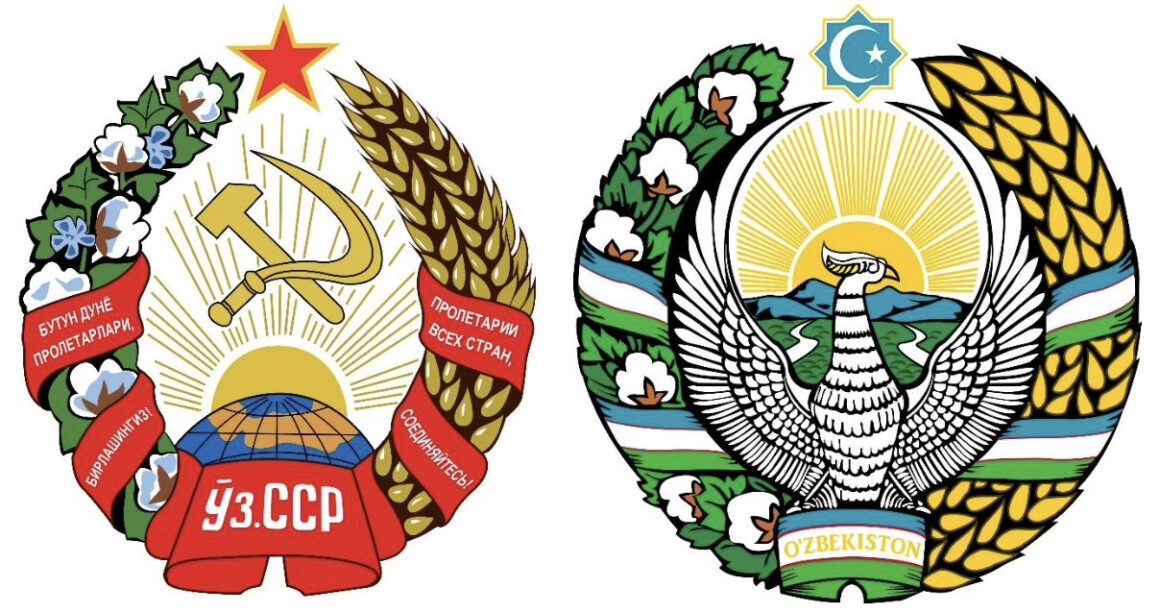
Source: wikipedia image
In closing, we may state that not only the form of coats of arms, but also the uniforms “of these independent countries did not change enough after 1992 to at least help the symbolic alienation from the Soviet past” (Kudaibergenova 2014, p. 167). After all, it seems as though nationalism still has ample room to redesign military attire and badges, and hence facilitate such a symbolic transformation.
References
- Abazov, Rafis. 2007. Culture and Customs of the Central Asian Republics. London: Greenwood Press.
- Adams, Laura L. 2010. The Spectacular State: Culture and National Identity in Uzbekistan. Durham, NC: Duke University Press.
- Barker, A. J. 1976. Soviet Army Uniforms and Insignia 1945:75. London: Arms and Armour Press.
- Bassin, Mark, and Catriona Kelly, eds. 2012. Soviet and Post-Soviet Identities. Cambridge, UK: Cambridge University Press.
- CSM (blog). 2011a. Mutasd az egyenruhád, megmondom, kivel vagy (?) 1. http://katpol.blog.hu/2011/09/12/mutasd_az_egyenruhad_megmondom_kivel_vagy.
- CSM (blog). 2011b. Mutasd az egyenruhád, megmondom, kivel vagy (?) 2. https://katpol.blog.hu/2011/09/26/mutasd_az_egyenruhad_megmondom_kivel_vagy_2
- Davies, Norman. 2012. Vanished Kingdoms: The History of Half-Forgotten Europe. London: Penguin Books.
- Everett-Heath, Tom, ed. 2003. Central Asia: Aspects of Transition. London: Routledge.
- Haerpfer, Christian W., and Kseniya Kizilova. 2020. “Values and Transformation in Central Asia.” In Transformation and Development: Studies in the Organization for Security and Cooperation in Europe (OSCE) Member States, edited by Anja Mihr, p. 7–28. Bishkek: OSCE Academy.
- Kudaibergenova, Diana T. 2014. “National Identity Formation in Post-Soviet Central Asia: The Soviet Legacy, Primordialism and Patterns of Ideological Development since 1991.” In Social and Cultural Change in Central Asia: The Soviet Legacy, edited by Sevket Akyldiz and Richard Carlson, p. 160–173. London: Routledge: London.
- Kulchik, Yuriy, Andrey Fadin, and Victor Sergeev. 1996. Central Asia after the Empire. London: Pluto Press.
- Marat, Erica. 2010: The Military and the State in Central Asia. Abingdon: Routledge.
- Olcott, Martha Brill. 1996. Central Asia’s New States: Independence, Foreign Policy and Regional Security. Washington, DC: US Institute of Peace Press.
- Paskaleva, Elena, and Gabriella van den Berg, eds. 2023. Memory and Commemoration across Central Asia: Texts, Traditions and Practices, 10th to 21st Centuries. Leiden Studies in Islam & Society. Leiden: Brill.
- Schwartz, Christopher. 2014. “The Relics of 1991: Memoires and Phenomenology of the Post-Soviet Generation.” In Social and Cultural Change in Central Asia: The Soviet Legacy, edited by Sevket Akyldiz and Richard Carlson, p. 188–200. London: Routledge.
Footnotes
1 The Oghuz Turkic Seljuk Dynasty established the Seljuk Empire (1037–1194), which is seen by present-day Turkmen leaders as the predecessor of the state of Turkmenistan.
2 Manas is the title and main fictional character of the Kyrgyz epic poem set in the 9th century.
3Amir Timur (1336–1405) was a Turco-Mongolian conqueror who founded the Timurid Empire in Central Asia.
4Abylai Khan (1711–1781) was the last independent khan of the Kazakh Khanate before the era of Russian dominance.
5Altyn Adam is the name of an ethnic Saka warrior buried in gilded clothes and unearthed during an archaeological exploration in 1969–1970 in present-day Kazakhstan.

